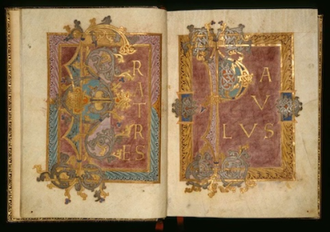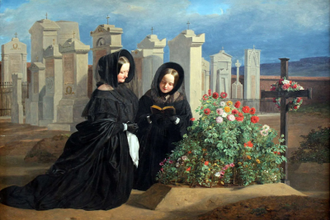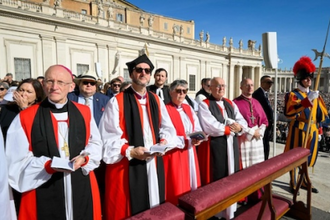Gospel in Art: The scroll of the prophet Isaiah was given to him

Epistle Lectionary by Eburnant (artist). MS McClean 30. Illuminated manuscript, 960-980 AD, Frankish Kingdom, Reichenau © The Fitzwilliam Museum, Cambridge
Source: Christian Art
Gospel of 26 January 2025
Luke 1:1-4; 4:14-21
Inasmuch as many have undertaken to compile a narrative of the things that have been accomplished among us, just as those who from the beginning were eyewitnesses and ministers of the word have delivered them to us, it seemed good to me also, having followed all things closely for some time past, to write an orderly account for you, most excellent Theophilus, that you may have certainty concerning the things you have been taught.
At that time: Jesus returned in the power of the Spirit to Galilee, and a report about him went out through all the surrounding country. And he taught in their synagogues, being glorified by all.
And he came to Nazareth, where he had been brought up. And as was his custom, he went to the synagogue on the Sabbath day, and he stood up to read. And the scroll of the prophet Isaiah was given to him. He unrolled the scroll, and found the place where it was written,
'The Spirit of the Lord is upon me, because he has anointed me to proclaim good news to the poor.
He has sent me to proclaim liberty to the captives and recovering of sight to the blind,
to set at liberty those who are oppressed, to proclaim the year of the Lord's favour.'
And he rolled up the scroll, and gave it back to the attendant, and sat down. And the eyes of all in the synagogue were fixed on him. And he began to say to them, 'Today this Scripture has been fulfilled in your hearing.'
Reflection on the 10th century Lectionary
At Mass, when the minister of the Word steps forward to proclaim Scripture, the readings are taken from a book known as the lectionary. Then the priests steps forward to read the Gospel, also from the lectionary. The Church provides a structured cycle of readings for our liturgical celebrations: a three-year cycle for Sunday readings and a two-year cycle for weekday readings. This practice has its very roots in the synagogue worship of Jesus' time, which centred on a liturgy of the word. In those services, there would be first a reading from the Pentateuch (the first five books of the Bible), then accompanied by a reading from the prophets, followed by prayers.
In today's Gospel account, we hear of Jesus returning to his hometown of Nazareth for the first time after beginning his public ministry. He went to the synagogue on the Sabbath, just as we gather for Mass on Sundays. During the service, Jesus was invited to read a passage from the prophets. However, rather than following a prescribed reading, he chose a passage himself. He asked for the scroll of the prophet Isaiah, unrolled it to locate a specific passage and read. It is a beautiful reading highlighting Jesus' own profound connection with Scripture. By selecting the reading from Isaiah, he reveals its deeper fulfilment in his own mission: bridging the ancient word with his presence among the people.
Our artwork today is an illustration of a Lectionary, executed between 960-980 AD in the Frankish Kingdom. It is truly beautiful. Our illustration shows the double page spread caption page for the letters of Saint Paul. The manuscript was illuminated (painted) by Eburnant, a scribe and illuminator active in the late 10th century, associated with the Reichenau Abbey, a prominent center of Ottonian art and manuscript production. This Lectionary features a harmonious use of gold, silver, and purple, emulating the luxurious volumes produced at the courts of the Roman and Byzantine Empires. The palette includes carbon black, lead white, ultramarine blue, vermilion red, verdigris green, orpiment yellow, and a pink dye, showcasing the sophisticated techniques employed by Eburnant and his contemporaries.
LINKS
Gospel in Art: https://christian.art/
Today's Reflection: https://christian.art/daily-gospel-reading/luke-1-1-4-2025/


















